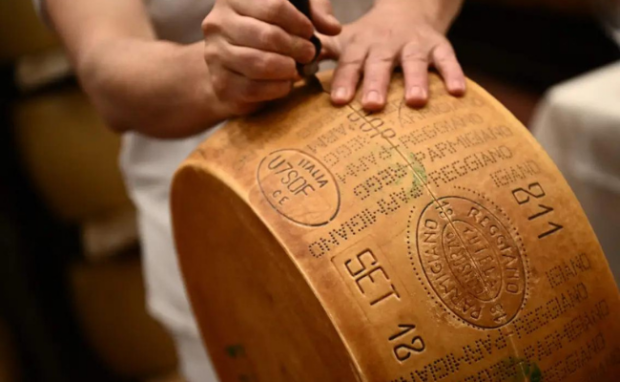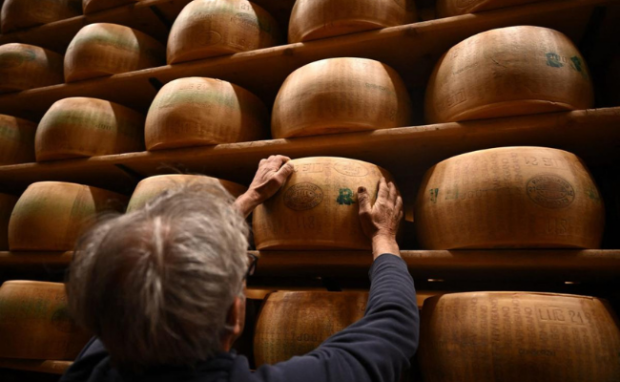Parmesan makers fight fakes with microchips
Most people can buy parmesan cheese in supermarkets, but did you know Europe follows stricter rules for this food? People in that part of the world may only produce Parmesan or Parmigiano Reggiano from specific Italian regions. Nowadays, Italy protects the identity of its cultural food product with an unlikely tool: microchips!
Licensed parmesan makers embed microchips into the rinds of their cheese wheels to authenticate them. They are as small as salt grains, but they secure these food products with a blockchain, the computer networks behind cryptocurrencies. Believe it or not, some countries are testing this application, which may become a standard for food supply chains.
This article will discuss why and how parmesan microchips became a standard practice for Italian cheese wheels. Later, I will explain a similar project in the Philippines.
How do the Parmesan microchips work?

Photo Credit: businessinsider.com
Parmesan cheese makers insert microtransponders roughly the size of a grain of salt into cheese wheel rinds. The latter is the hard skins of milk protein casein surrounding cheese wheels.
These microchips are part of a wheel’s casein label, with an identification number and QR code. A person can use a laser chip reader to activate the chip’s circuit to check the origin of a cheese wheel.
It is a long-lasting, scannable food tag created by the US company p-Chip Corporation that functions like “tiny digital anchors for physical items.” The Guardian says producers need this technology as exportation spreads its exposure to the international market.
You may also like: Italy’s digital divide
Parmigiano Reggiano Consortium president Nicola Bertinelli explained why digitalization is the solution. He said the tracking process “conveys the value of our product globally and distinguishes it from similar-sounding products on the market that do not meet our strict requirements for production and area of origin.”
The casein label was insufficient to prevent counterfeits, so the microchip added more protection. PRC representative Alberto Pecorari knows it will not be effective forever. Nevertheless, he said, “We keep fighting with new methods. We won’t give up.”
Why use Parmesan microchips?

Photo Credit: finance.yahoo.com
You may recognize Parmesan as a topping on a salad or pasta. However, Italy takes it more seriously because it traces its history back to the middle ages.
It is also one of the most counterfeited cheeses in the world. The Guardian says its Parmegiano Reggiano Consortium (PRC) has been fighting these imitators for hundreds of years.
In 1996, the country gained the European Union’s protected designation of origin (PDO) for its prize cheese. PDO applies to foodstuffs “produced, processed, and prepared in a given geographical area using recognized know-how.”
Consequently, Parmesan or Parmigiano Reggiano may only come from the Italian provinces of Parma and Reggio Emilia. Also, their cheese wheels must only weigh 40kg (88 lbs) on average.
Makers must mature their cheese in a mountainous area for at least 12 months. Then, experts must test them two years after production to ensure they meet standards.
Other foods with PDO status include Portuguese port, kalamata olive oil, and French champagne. Their stringent certification fetches high prices for these delicacies, making them an ideal target for copycats.
The PRC estimates annual global sales of fake cheese reach roughly $2 billion or £1.6 billion. Conversely, the authentic one reached record sales of €2.9 billion last year.
Is there a similar food supply tracking project?
Another country from the other side of the world is testing digital food tracking. The Philippines uses blockchain technology to track mangoes from Guimaras.
The Guimaras mango is the first Filipino food that earned the Certificate of Geographical Indication (GI). Think of it as the Parmigiano Reggiano’s Filipino counterpart.
Provincial Economic Development (PED) Officer Francisco E. Gentoral said, “It’s geographic, which means it comes from Guimaras. It means that other areas claiming as Guimaras mangoes can be questioned by the province.” Consequently, it requires authentication.
You may also like: Meta vs. Tesla CEO fight may occur in Roman Colosseum
The Department of Science and Technology launched the “Application of Blockchain Technology to the Guimaras Mango Supply Chain” under its Regional Research Institution (RRI) program. Dr. Maureen Nettie N. Linan explained the project on the DOST-PCIEERD’s YouTube channel:
- She divided the mango supply chain into five parts: growers, wholesales, processors, exporters, and retailers.
- Distribution starts from the growers and ends with retailers, but each succeeding step must establish a smart contract before the mango supply advances. For example, growers and wholesales must confirm Guimaras mango authenticity and amounts before it proceeds to processors.
- Smart contracts are agreements that execute automatically once certain conditions are met. Also, a world state tracks a mango supply based on smart contracts. For example, a smart contract between processors and exporters means the mangoes are en route to the retailers.
Each part of the supply chain can track the fruits with an app. As a result, the system promotes transparency and authenticity of the Guimaras mango supply chain.
Conclusion
Parmesan microchips are Italy’s latest tool for keeping its time-honored food product authentic. These allow people to check where a cheese wheel originated.
In other words, you can scan rinds to confirm your Parmesan is 100% genuine. Also, the Philippines implemented a similar system for its “sweetest” Guimaras mangoes.
These methods may become a staple for most food products as more countries use them. Learn more about the latest digital tips and trends at Inquirer Tech.